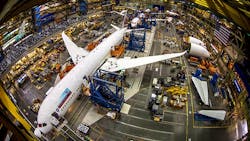5 Key Trends Impacting the Aerospace Sector and What They Mean for Growth
In recent years, the skies have been quite friendly for the aerospace sector. With a growing demand for air travel, massive backlogs of new aircraft orders and a slowly resurging business jet sector, outlook for the industry is strong. But underneath the headline data are signs that the industry is undergoing a shift that will see significant consolidation within areas of the supply base and downward pressure on profits as the original equipment manufacturer (OEMs) ramp up production of increasingly advanced platforms.
Key Trends to Watch
While long term outlook remains strong, there are a number of emerging and evolving trends we see that will continue to influence growth over the near-term.
Continued Technological Advancement
Radical improvements in operating efficiency, advanced avionics and impressive interior cabin designs and noise reduction capabilities are all driving increased customer demand. But the wider use of composites, advanced manufacturing technology requirements and conversion to new electrical systems are also rapidly changing the way aircraft are manufactured and creating challenges across the supply chain as the supply base struggles to make the changes necessary to keep up with aircraft OEM demands. New, more advanced platforms are already in production – the A320 neo and Boeing’s 787, for example – and more are expected in the near future including the 737 MAX, the 777x, the A330 neo and Bombardier’s C-Series.
Strong Replacement Demand Bolsters Books
With rapidly aging fleets in the mature markets and growing demand from airlines and fleet operators for next generation, more fuel-efficient, technologically-advanced aircraft, many customers are now focused on replacing their older fleets. In fact, over the next 20 years, it is estimated that around 40% of all new aircraft deliveries will be for replacement purposes. However, extended periods of depressed fuel prices may encourage aircraft operators to defer replacement of fuel-guzzling aircraft without incurring higher operations costs.
Supply and demand balance may be tilting
Some have voiced concerns that the OEMs may be oversupplying the market (deliveries increased by 30% between 2009 and 2014), yet evidence suggests that supply and demand may actually be balanced currently. However, with forecasts predicting an increase in build-rates of another 40% by 2020, seat deliveries are expected to out-pace demand for air travel. While the OEMs are expected to deliver seats at a rate of around 8% to 9% of the active fleet, airlines are expected to replace about 2.5% to 3% of their installed capacity while new growth is expected to stay at around 5% of capacity (slightly lower than the 5% to 6% expected growth in RPMs, due to efficiency improvements), thereby creating an oversupply of 1% to 2% of active fleet (approximately 300 aircraft or 40,000 to 50,000 seats). We expect Boeing and Airbus to scale back announced build-rates, in particular in the wide-body sector, especially with continued weakness in global economies, low oil prices and a deceleration in global air traffic as the transport market matures.
Lower Oil Prices Influencing Both Demand and Growth
Not surprisingly, the sustained level of lower oil prices since its collapse in late 2014 has spurred airline profitability but has industry analysts wondering whether continued depressed levels will temper short-term replacement demand for next generation aircraft. However, this has had little impact on the OEM order books, in part because the business case for such investment decisions typically covers a 20 to 30-year horizon and is therefore much more influenced by the long-run expectations for oil. Interestingly, while long-run expectations have fallen dramatically, there have been few signs of its impact on the active fleet:there have been few signs of airlines engaging in higher utilization of older generation aircraft, based on latest airline fleet schedules, nor of any reduction in aircraft retirements or increases in the number of parked aircraft re-entering the active fleet. At the same time, it is widely believed that lower oil prices will lead to even higher growth in air traffic as fuel savings translate into lower fares and individuals shift the savings they receive from lower energy costs towards discretionary spending such as leisure travel.
Continued Appreciation of the U.S. Dollar and Higher Borrowing Rates
The U.S. dollar’s strength is a major consideration for the aerospace outlook. Since June 2014, the dollar has increased 20% against the currencies of the U.S.’s major trading partners and has risen more than 50% against emerging-market currencies such as Brazil and Russia. In 2016, we expect the Federal Reserve will increase its policy rates by no more than two moves, keeping interest rates still historically low. The gradual pace of Fed hiking should limit further appreciation of the U.S. dollar—although geopolitical events and foreign monetary policy could offset that expectation. Nevertheless, the recent strength of the U.S. dollar will continue to create challenges for non-U.S. players and even small changes in short term rates may dampen demand. The currency challenge may be particularly sharp for developed market carriers who generate sales in local currencies but purchase new aircraft in U.S. dollars, as any appreciation in the U.S. currency will directly impact the affordability of U.S. dollar denominated new aircraft purchases. Given that approximately 34% of the combined backlog held by Boeing (26%) and Airbus (41%) relates to the emerging markets, continued appreciation of the U.S. dollar may impact the strength of the OEMs’ order books.
Doug Gates is global aerospace and defense sector leader at KPMG LLP. The views expressed in this commentary do not necessarily represent the views of KPMG.

